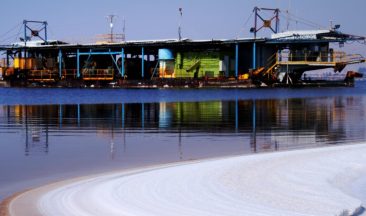Regenerative agriculture is the latest buzzword in the world of climate change. It uses alternative farming and grazing practices that build up soil organic matter and restore degraded soil biodiversity. You may well ask, what is regenerative agriculture? Regenerative agriculture is as much a philosophy as it is a practice, having been defined as a holistic land management practice that leverages the power of photosynthesis in plants to close the carbon cycle. It allows for relationships to foster across ecosystems around the globe.
Background and History
Regenerative agriculture is nothing new. Before the onslaught of colonialism, indigenous communities around the world relied on low-tech farming practices to restore the local ecology from one growing season to the next.
These practices included allowing large animals to graze freely across grasslands, making their own contributions to the fertility of the soil, and promoting the diversity of microbial growth.
Back then, climate change was not a significant issue. These “old school” methods kept carbon dioxide (CO2, the key culprit in climate change) in a regular cycle, going from soil to the sky and back again. This prevented it from accumulating and carrying out its role as the chief “greenhouse gas,” raising the Earth’s temperature to a dangerous degree.
Where does carbon come from? Carbon can be found in every living thing on earth; it is the backbone of every biological molecule. Therefore, it can also be found in things that used to be living, such as oil, coal, and other fuels derived from animals that died long ago (i.e., fossil fuels).
Carbon is an easily transferable element and often leaves its sources through respiration and decay, or burning fossil fuels. Some carbon ends up in the atmosphere, in the form of carbon dioxide, and some of it ends up in the ground, around the plants’ roots to attract various organisms in the soil such as bacteria, fungi, and nematodes.
They then release additional carbon back into the soil, which the plant uses for photosynthesis, and may further release carbon back into the air through respiration as CO2. This cyclical process is known as the carbon cycle.

Carbon in the air. CO2 is one of several greenhouse gases. Others include methane, ozone, and nitrous oxide, which can trap the sun’s radiant energy, and keep the heat close to Earth-like in a greenhouse.
A little extra heat now and then keeps the Earth warm enough to keep its resident life forms alive and thriving. When the greenhouse effect gets out of control, rising temperatures cause glaciers to melt. More water is then available to evaporate into the air, increasing precipitation and making ocean waves bigger and bigger, leading to tidal waves and torrential rains.
Climate change. Scientists have been able to track the “history” of climate change merely by examining the rings in tree trunks, bubbles of air trapped in polar ice, and the ratio of stable isotopes of oxygen and hydrogen in water molecules. They found that the average environmental temperature has been relatively stable over the last 8000 years, which includes most of recorded human history.
They also found that carbon dioxide levels in the air hovered around 280 parts per million (ppm) during that time, spiking occasionally during periods of agricultural expansion and then falling back to normal. Since the Industrial Revolution, however, carbon levels in the air have been on a fairly steady climb, reaching 418 ppm in January 2022.
Given that a pretty efficient carbon recycling system is already set up in nature, one might wonder how carbon dioxide levels get so dangerously high. It turns out that humans have a lot to do with it. While we need to reduce the use of fossil fuels to decrease greenhouse gas production, regenerative agriculture presents an opportunity to preserve the world’s fertile soil and biodiversity and offers long-term effects that can mitigate global warming and improve the productivity of our soil.
Principles of Regenerative Agriculture
Regenerative agriculture has been defined broadly as agricultural practices with the primary objective to regenerate soils or increase the organic content to improve the soil’s fertility. This approach conserves and restores soil organic matter by protecting the habitats of micro and macro-organisms. Some benefits of regenerative agriculture also include enhanced soil health, improved soil water conservation, and erosion resistance. Among the approaches to this goal are the following:
- Minimize soil disturbances. Limiting or avoiding tilling to minimize disturbances to the physical, biological, and chemical nature of the soil.
- Provide continuous soil coverage. Replacing tilling with farming practices that keep the soil covered with vegetation and natural materials through mulching, cover crops, and pastures.
- Increase plant diversity. By promoting a diversity of wildlife and pollinators, farmers can achieve healthy soil that retains excess water and nutrients and may provide an additional stream of revenue.
- Keeping living roots in the soil as much as possible. Having living roots in the soil ensures that fields are never bare. This can be achieved by planting winter cover crops or maintaining the land as a permanent pasture. Keeping living roots in the soil helps stabilize the soil, retain excess water, and prevent nutrient runoff.
- Integrate animals into the farm as much as possible. Livestock manure adds valuable nutrients to the soil, increasing the amount of organic matter in the soil. This soil will capture large amounts of carbon and water and reduce the amount of polluted runoff.
- Implementing crop rotation. Compared to monoculture practices, rotating crops each year helps control pathogens, minimize insect, and weed pressure, and helps reduce the need for pesticide and insecticide applications. A diversified crop rotation also improves soil structure by diversifying the length of rooting zones, which promotes water infiltration. Different crops have different nutrient needs and crop residues will promote a more balanced and resilient soil ecosystem.
Benefits of Regenerative Agriculture
Many of the techniques used in regenerative agriculture contribute more than “just” a healthy crop. Crop rotation, for example, disrupts the reproductive cycle of common pests, thereby reducing the need for pest control.
The use of cover crops between harvests and planting seasons reduces weed growth—and, therefore, weeding. No-tillage systems increase soil organic matter by reducing mineralization rates and leaving crop residues in the shallow soil. The “no-till” practice also retains topsoil, reducing the additional expense of replacing it each year and rotational grazing saves on feed costs and prevents soil erosion.
AgTech’s Role in the Success of Regenerative Agriculture
The AgTech industry can support the efforts of regenerative agricultural practices by providing agtech solutions for protecting the environment in at least three important ways:
Protect the waterways:
A primary goal of regenerative agriculture is to reduce soil erosion caused by runoffs. AgTech companies can offer advice on efficient irrigation technology and help in selecting the most cost-effective equipment.
They can also help in aligning irrigation plans with water availability in the watershed and the needs of other users in the community. Rice growers, for example, might be advised to reduce the length of time the soil is flooded in order to reduce methane gas emissions.
Meet consumer demands:
Consumers are now more conscious than ever of their preferences. It has been estimated that 75% of millennials are willing to change buying habits with the environment in mind, meaning food producers would benefit by trying to meet these consumer demands. This can be done by providing consumers with information about technological advances that can trace regenerative agricultural practices.
Satellites, smart sensors, and other technological developments will allow consumers to track food producers for their success in reducing greenhouse gas emissions and promoting soil health and biodiversity.
More on the subject:
Top 10 Agriculture Trends to Watch in 2024
The Importance of Soil Health
Growing Media in Horticulture
Summary
Regenerative agriculture practices are beneficial for farmers, consumers, food security, and the environment. For example, no-till reduces soil erosion and encourages water to infiltrate soils. Cover crops do the same and can also reduce water pollution. Diverse crop rotations can lower pesticide use. Proper grazing practices — such as moving cattle around frequently, adding legumes or fertilizers, and avoiding overgrazing — can increase vegetation and protect water sources.
Though its potential to mitigate climate change is still being discussed and evaluated, there is no doubt that regenerative agriculture can improve soil health and fertility and provide other valuable environmental benefits.







